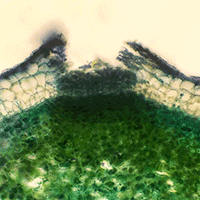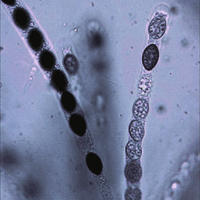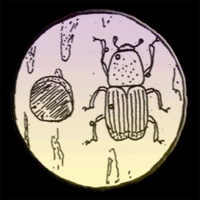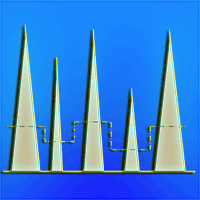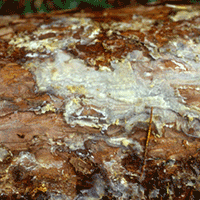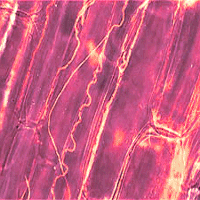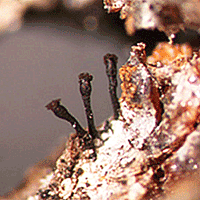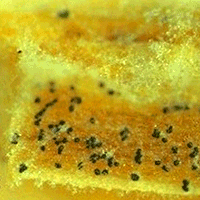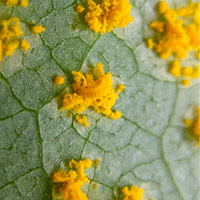
Variation in resistance to the rust fungus Melampsora larici-populina Kleb. in Populus nigra L. in the Czech Republic
Petra Štochlová, Katerina Novotná , Vojtech Benetka
iForest - Biogeosciences and Forestry, Volume 9, Issue 1, Pages 146-153 (2015)
doi: https://doi.org/10.3832/ifor1458-008
Published: Oct 26, 2015 - Copyright © 2015 SISEF
Research Articles
Abstract
Differences in Populus nigra L. clone resistance to the rust fungus Melampsora larici-populina Kleb. (MLP) were studied in field trials where infected trees were compared with fungicide-protected trees. MLP rust infections were assessed using a 6-point scale. Four parameters of poplar growth were also measured to gauge host response to infection: shoot thickness, shoot number at the end of the growing season, individual plant dry weight, and dry matter yield per unit area. Five of eight known pathogen virulence types were detected. Cumulative growth in shoot thickness in sprayed and unsprayed plots was similar in clones with high rust pathogen resistance, but significantly different in clones with low resistance. Clones with low resistance also exhibited delayed growth initiation in the year following infection, an effect attributed to lower food storage accumulated during the previous year, reflected in a reduction in stem diameter. Based on stem thickness measurements, it was confirmed growth ceased at the end of August. Average rust severity symptoms ranged from 2.75 to 4.22 on the 6-point scale. The percentage reduction for the various growth parameters resulting from rust infection ranged as follows: individual plant dry weight 5-64%; dry matter yield 21-66%; shoot number 17-46%; and stem diameter 1-35%. Exclusive of stem diameter, these reductions correlated with severity in MLP rust infection. The one exception was tolerance to rust infection displayed by one of the clones. Clones with the lowest growth reductions were 97/152 and 97/157. Growth and yield parameter variation as a result MLP resistance difference was observed among tested P. nigra clones. This variation can be viewed as confirmation that resistance observed in this study and P. nigra clones is a suite of quantitative traits. These findings have important implications for MLP resistance breeding programs.
Keywords
Stem diameter, Pathogen effects, Pathogen tolerance, Melampsora larici-populina virulence, Field infection
Authors’ Info
Authors’ address
Katerina Novotná
Vojtech Benetka
Silva Tarouca Research Institute for Landscape and Ornamental Gardening, Publ. Res. Inst., Kvetnové námestí 391, CZ-252 43 Pruhonice (Czech Republic)
Corresponding author
Paper Info
Citation
Štochlová P, Novotná K, Benetka V (2015). Variation in resistance to the rust fungus Melampsora larici-populina Kleb. in Populus nigra L. in the Czech Republic. iForest 9: 146-153. - doi: 10.3832/ifor1458-008
Academic Editor
Alberto Santini
Paper history
Received: Sep 26, 2014
Accepted: Oct 01, 2015
First online: Oct 26, 2015
Publication Date: Feb 21, 2016
Publication Time: 0.83 months
Copyright Information
© SISEF - The Italian Society of Silviculture and Forest Ecology 2015
Open Access
This article is distributed under the terms of the Creative Commons Attribution-Non Commercial 4.0 International (https://creativecommons.org/licenses/by-nc/4.0/), which permits unrestricted use, distribution, and reproduction in any medium, provided you give appropriate credit to the original author(s) and the source, provide a link to the Creative Commons license, and indicate if changes were made.
Web Metrics
Breakdown by View Type
Article Usage
Total Article Views: 50422
(from publication date up to now)
Breakdown by View Type
HTML Page Views: 41769
Abstract Page Views: 3832
PDF Downloads: 3469
Citation/Reference Downloads: 17
XML Downloads: 1335
Web Metrics
Days since publication: 3701
Overall contacts: 50422
Avg. contacts per week: 95.37
Citation Metrics
Article Citations
Article citations are based on data periodically collected from the Clarivate Web of Science web site
(last update: Mar 2025)
Total number of cites (since 2016): 5
Average cites per year: 0.50
Publication Metrics
by Dimensions ©
Articles citing this article
List of the papers citing this article based on CrossRef Cited-by.
References
Tolerance of parasites and disease in plants and its significance in host-parasite interactions. Advances in Plant Pathology 5: 161-197.
Gscholar
Characterization of two major genetic factors controlling quantitative resistance to Melampsora larici-populina leaf rust in hybrid poplars: strain specificity, field expression, combined effects, and relationship with a defeated qualitative resistance gene. Phytopathology 94: 1358-1367.
CrossRef | Gscholar
Breeding poplars with durable resistance to Melampsora larici-populina leaf rust: a multidisciplinary approach to understand and delay pathogen adaptation. In: Proceedings of the “4th International Workshop on Genetics of Host-Parasite Interactions in Forestry: Disease and insect resistance in forest trees” (Sniezko RA, Yanchuk AD, Kliejunas JT, Palmieri KM, Alexander JM, Frankel SJ eds). General Technical Report PSW-GTR-240, Pacific Southwest Research Station, Forest Service, USDA, Albany, CA, USA, pp. 31-38.
Online | Gscholar
La protection phytosanitaire du cultivar “Beaupré” - est-elle efficace? [Plant protection of the cultivar “Beaupré” - is it effective?] Informations Forêt 2, pp. 6. [in French].
Gscholar
Directory of poplar and willow experts. Register of Populus L. cultivars. Instituto di Sperimentazione per la Pioppicultura, Casale Monferrato, Italy. [CD-ROM]
Gscholar
Improving lives with poplars and willows. Synthesis of Country progress reports. In: Proceedings of the “24th Session of the International Poplar Commission”. Dehradun (India) 30 Oct-2 Nov 2012. Working Paper IPC/12, Forest Assessment, Management and Conservation Division, FAO, Rome, Italy, pp. 93.
Gscholar


